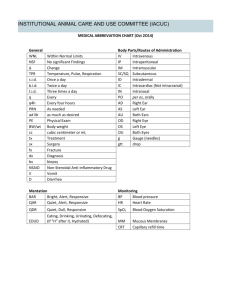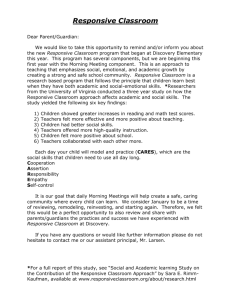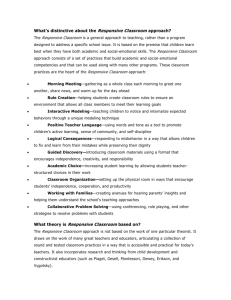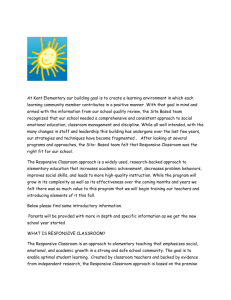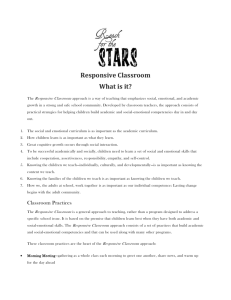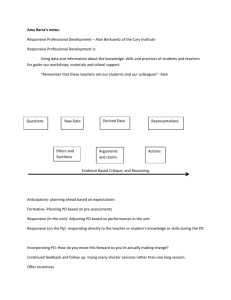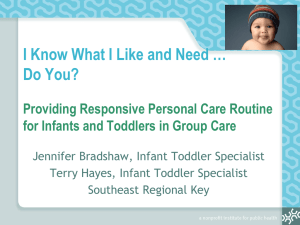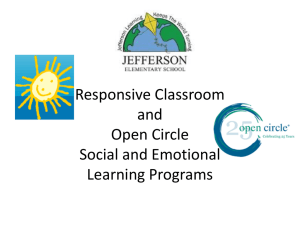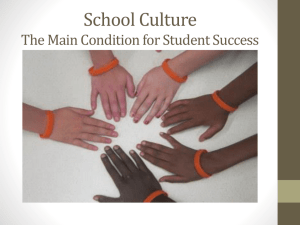Responsive Classroom - Harrisburg School District
advertisement
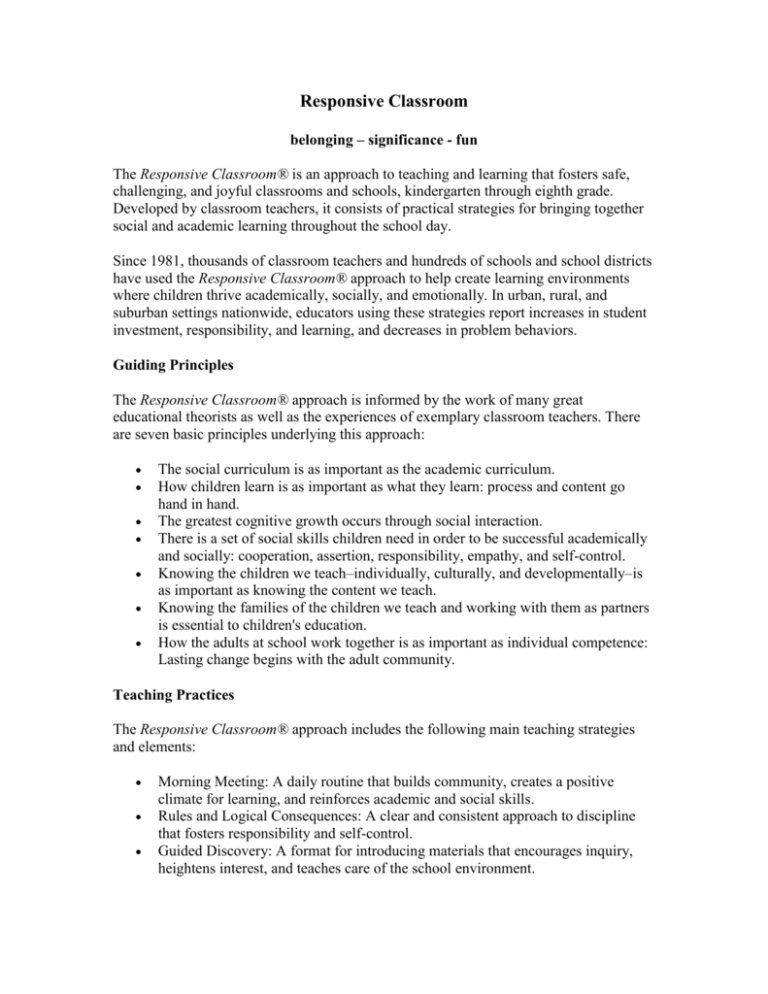
Responsive Classroom belonging – significance - fun The Responsive Classroom® is an approach to teaching and learning that fosters safe, challenging, and joyful classrooms and schools, kindergarten through eighth grade. Developed by classroom teachers, it consists of practical strategies for bringing together social and academic learning throughout the school day. Since 1981, thousands of classroom teachers and hundreds of schools and school districts have used the Responsive Classroom® approach to help create learning environments where children thrive academically, socially, and emotionally. In urban, rural, and suburban settings nationwide, educators using these strategies report increases in student investment, responsibility, and learning, and decreases in problem behaviors. Guiding Principles The Responsive Classroom® approach is informed by the work of many great educational theorists as well as the experiences of exemplary classroom teachers. There are seven basic principles underlying this approach: The social curriculum is as important as the academic curriculum. How children learn is as important as what they learn: process and content go hand in hand. The greatest cognitive growth occurs through social interaction. There is a set of social skills children need in order to be successful academically and socially: cooperation, assertion, responsibility, empathy, and self-control. Knowing the children we teach–individually, culturally, and developmentally–is as important as knowing the content we teach. Knowing the families of the children we teach and working with them as partners is essential to children's education. How the adults at school work together is as important as individual competence: Lasting change begins with the adult community. Teaching Practices The Responsive Classroom® approach includes the following main teaching strategies and elements: Morning Meeting: A daily routine that builds community, creates a positive climate for learning, and reinforces academic and social skills. Rules and Logical Consequences: A clear and consistent approach to discipline that fosters responsibility and self-control. Guided Discovery: A format for introducing materials that encourages inquiry, heightens interest, and teaches care of the school environment. Academic Choice: An approach to giving children choices in their learning that helps them become invested, self-motivated learners. Classroom Organization: Strategies for arranging materials, furniture, and displays to encourage independence, promote caring, and maximize learning. Family Communication Strategies: Ideas for involving families as true partners in their children's education. Research Six studies: improvements in social skills, academic behaviors, and decreases in problem behaviors 1. 2. 3. 4. 5. 6. standardized test scores increased discipline referrals decreased increased practices in peer inclusion teachers asked to be trained teachers and students said they like Responsive Classroom significant improvement in social skills A Multi-year Evaluation of the Responsive Classroom® Approach: Its effectiveness and acceptability in promoting social and academic competence Location: Springfield, MA Year: 1996-98 Principal Investigator: Dr. Stephen N. Elliott, University of Wisconsin, Madison Funder: Shinnyo-En Foundation Duration: Two Years Summary: A two-year (1996-1998) University of Wisconsin study by researcher Stephen Elliott two schools in Springfield, Massachuetts, used Responsive Classroom program in one school and not in the second school. There were significant social and academic gains for the students in the Responsive Classroom program. Teachers reported an increase in such student social skills as using time appropriately, initiating conversations with peers, and getting along with people who are different. They also reported a decrease in such problem behaviors as interrupting, excessive fidgeting or moving, and feeling anxious among other children. The control group reported much less improvement in those areas. Over the two-year period, the Responsive Classroom group also showed significantly greater growth on the Iowa Test of Basic Skills. In 1999, fourth grade test scores at the school using Responsive Classroom were the most improved in the state. Social and Academic Learning Study (SALS) Year: 2001-2004 Principal Investigator: Dr. Sara E. Rimm-Kaufman, University of Virginia Duration: Three Years Summary: teachers report positive attitudes toward teaching teachers feel more effective in their approach in discipline teachers report greater ability to create positive school climate ad greater ability to influence decision-making teachers more similar to exemplars in their priorities and teaching practices Responsive Classroom Strategies Morning Meeting: builds a sense of community and lets students know they’re important, which leads to trust and a sense of safety that promotes classroom success Greeting Sharing Group activity News and announcements Students often conduct the meeting, and they form a self-governed group. The meeting gives students a voice and some decision-making opportunities, as student behavior typically improves through this community building process. When students feel alienated, they tend to lash out, and the meeting instead helps them feel connected and gives them practice speaking up. Rules and Logical Consequences: Class articulates hopes and dreams as foundation of establishing rules that will help these hopes come true. Logical consequences help children develop inner control by looking closely at their own behavior and learning from their mistakes. Logical consequences are related to the behavior, not the child, are respectful of the child, and are reasonable helping students articulate their goals for the school year creating rules that help them achieve their goals modeling, practicing, and role playing the rules using language effectively to reinforce the rules teaching about logical consequences for rule-breaking responding effectively to rule-breaking living by the rules outside the classroom First Six Weeks of School daily plans for the first three weeks of school at three grade levels detailed guidelines for building community, teaching classroom routines, fostering autonomy, and establishing high expectations for learning and behavior collection of activities, greetings, songs, read-alouds, and resources Academic Choice: a way to structure lessons and activities teacher decides on goal of the lesson or activity students are given list of options for what to learn and/or how to go about their learning in order to reach the defined goal aligns with HighScope plan-do-review o students plan what they will do, how they will do it, and how they will show their work o after completing the task, children reflect on the work they did and the learning that occurred in order to make sense of concrete experiences purposes of Academic Choice o to help children learn new skills or information o to help children practice new skills o to have children demonstrate mastery of skills or content benefits of Academic Choice o support children’s intrinsic motivation to learn o encourages children to learn from each other o draws on different strengths, abilities, and interests o maximizes children’s learning Working with parents working with diverse family cultures setting the stage for a positive relationship during the early weeks of school keeping in touch all year long talking with parents about child development involving all parents helping parents understand classroom practices problem-solving with parents Classroom spaces that work setting up a meeting area creating meaningful displays arranging furniture selecting and organizing materials eliminating clutter storing supplies accommodating special needs making the space healthy
